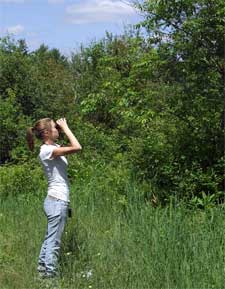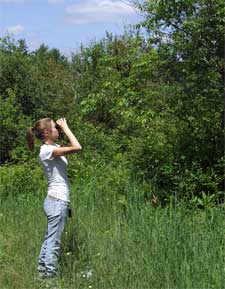 KINGSTON, R.I. – January 3, 2013 – Wildlife officials in the Northeast often encourage owners of large tracts of forested land to cut some of their trees to create openings in the forest to attract woodcocks, a declining native bird that prefers shrub- or sapling-dominated habitat. The officials’ sales pitch may have just gotten a little easier, thanks to research by a University of Rhode Island senior who found that managing land for woodcocks is beneficial to a wide variety of songbirds and other wildlife.
KINGSTON, R.I. – January 3, 2013 – Wildlife officials in the Northeast often encourage owners of large tracts of forested land to cut some of their trees to create openings in the forest to attract woodcocks, a declining native bird that prefers shrub- or sapling-dominated habitat. The officials’ sales pitch may have just gotten a little easier, thanks to research by a University of Rhode Island senior who found that managing land for woodcocks is beneficial to a wide variety of songbirds and other wildlife.
Lindsey Barnard, a wildlife and conservation biology major from Warwick, spent the last six months evaluating the habitat where woodcocks are known to breed and feed, comparing the variety of songbirds found there to mature forests that woodcocks avoid.
“There has been a movement to encourage landowners to create these openings in the forest, but there is a negative perception by the public that cutting trees down is a bad thing,” said Barnard. “Clear-cutting forests creates the openings that woodcocks spend the night in, and as the forests regenerate, it creates the shrubby habitat that they use during the day.”
Woodcock populations have been declining for more than 35 years due to habitat loss.
Barnard studied 10 actively maintained, open sites where woodcocks have been observed performing courtship flights and 10 unmanaged sites of unsuitable forested habitat. At each site, she recorded the number and species of birds she saw or heard and measured the vegetation to characterize the habitat. Over the course of the study, she identified a total of 22 songbirds in the woodcock habitat and 16 in the forested habitat.
“We found the diversity and abundance of songbirds was significantly higher at areas that are actively managed for woodcock,” said Barnard. “Managed areas support a higher diversity of songbirds, which means that managing for woodcock creates habitat that supports a larger and more diverse bird community.”
The habitat is also beneficial to many small mammals and other species dependent on low, shrubby vegetation that provides protective cover.
Barnard’s research was conducted as part of the URI Coastal Fellows Program, a unique initiative designed to involve undergraduate students in addressing current environmental problems. Now in its 17th year, it is based at URI’s College of the Environment and Life Sciences. Students are paired with a mentor and research staff to help them gain skills relevant to their academic major and future occupations.
One skill the URI student learned from her research project was the ability to identify birds just by hearing their songs.
“It’s really cool to hear them and know what you’re listening to,” she said. “It was a fun experience and a very educational one, too.”
Barnard’s woodcock habitat study wasn’t her first foray into wildlife research. She also joined a 2010-11 survey of New England cottontails that found just one of the state’s native rabbit in all of Rhode Island, despite having more than 100 students searching for them.
Barnard, who describes herself as “a huge animal lover” who is anxious to help protect endangered species, works as a Delta Airlines ticket agent and a barista at Updike’s Newtowne Coffee Roasting Company when not in class or in the field studying wildlife.
As she prepares to graduate from URI in May, Barnard is evaluating graduate school and job opportunities.
“I’d like to get some work experience first before deciding on a direction for grad school,” she said. “I never thought I’d be that into birds, but they’re much more interesting than I imagined. But I’d also like to work with large mammals. Whether it’s birds or bears, I don’t know right now. I’m just looking for the right opportunity.”
Photo submitted by Lindsey Barnard

